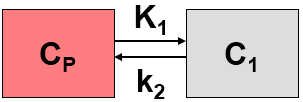This model implements the 1-tissue compartment model for H215O water PET studies developed by E. Meyer [1].

Operational Model Curve
It is assumed that at by the arrival in tissue the true input curve Cp(t) has been dispersed. This dispersion is modeled by convolving Cp(t) with an exponential kernel

whereby the parameter τ is called Dispersion. Incorporating the convolution into the 1-tissue compartment model and solving it using the Laplace transform yields the following analytic formula for the tissue concentration

K1 represents flow, and k2 flow divided by the partition coefficient p.
The operational equation is given by

Note that in this particular case there is no difference between the plasma and blood concentrations Cp(t) and CB(t) because water is a freely diffusible tracer.
Parameter Fitting
The tissue model includes four fitable parameters vB, K1 , k2, (Flow/Part.Coeff), τ (Dispersion). Per default, however, vB is fixed at vB=0 as in the original model. For water studies with the blood activity sampled in a peripheral artery, the resulting input curve is delayed respect to the arrival in tissue. In this case, the model should be fitted using the Fit region and blood delay button.
Implementation Note
Unlike the standard compartment models in PKIN the model curve of the operational equation is not calculated by integrating a set of differential equations, but rather using the analytical solution given above. The convolution integral is approximated by summing rectangles of 0.1sec in length, assuming that the acquisition time of dynamic water studies is short.
Reference
1.Meyer E: Simultaneous correction for tracer arrival delay and dispersion in CBF measurements by the H215O autoradiographic method and dynamic PET. J Nucl Med 1989, 30(6):1069-1078. PDF